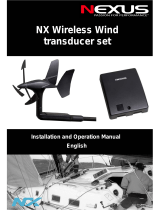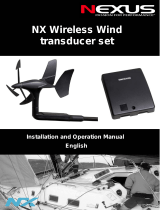
English WIND Pack
2
1 Installation..................................................................................................................................5
1.1 Installing the instrument............................................................................................................6
1.1.1 Installing instrument to the WSI-box..............................................................................7
1.2 Installing the WSI-box...............................................................................................................8
1.3 Installing the Wind Transducer .................................................................................................8
1.3.1 IMPORTANT Installation information!............................................................................8
1.3.2 Location.........................................................................................................................8
1.3.3 Mounting in the mast head ............................................................................................8
1.3.4 Mounting the wind transducer step by step...................................................................9
2 Connection to other Nexus systems......................................................................................10
3 Pairing procedure of wind transducer ...................................................................................10
4 Re-initialization of the wind transducer.................................................................................11
5 Maintenance!............................................................................................................................11
6 Change transducer or WSI-box / Release the pairng............................................................11
7 First start (only in a Nexus Network)......................................................................................13
7.1 Initialising the instrument.........................................................................................................13
7.2 Re-initialising the instrument...................................................................................................13
8 Operation..................................................................................................................................14
8.1 How to use the push buttons...................................................................................................14
8.1.1 Lighting........................................................................................................................15
8.2 Main function...........................................................................................................................15
8.3 Analogue function ...................................................................................................................15
8.4 Sub-functions..........................................................................................................................16
8.4.1 Apparent Wind Speed [AWS] ......................................................................................16
8.4.2 True Wind Speed [TWS]..............................................................................................16
8.4.3 Velocity Made Good (VMG).........................................................................................16
8.4.4 Boat speed...................................................................................................................16
8.4.5 Start up mode..............................................................................................................16
8.5 More functions in a Nexus Network.........................................................................................17
8.5.1 Count down display .....................................................................................................17
8.5.2 Geographic Wind direction (TWD)...............................................................................17
9 Calibration ................................................................................................................................18
9.1 User settings, C10...................................................................................................................18
9.1.1 Select the dampening, C11 .........................................................................................18
9.1.2 Select main information, C12.......................................................................................18
9.1.3 Beep when a key is pressed, C13 ...............................................................................18
9.1.4 Select unit for BSP/VMG, C14.....................................................................................19
9.1.5 Calibration of log transducer, C15...............................................................................19
9.1.6 Reference for Speed, water or GPS, C16....................................................................19
9.1.7 Reference for Direction, C17.......................................................................................19
9.1.8 Where is the wind Tx connected, C18.........................................................................20
9.1.9 Demo mode selection, C19 .........................................................................................20
9.1.10 Closed hauled PAGE, C20..........................................................................................20
9.2 Wind Settings, C50 .................................................................................................................21
9.2.1 Unit for Wind speed, C52 ............................................................................................21
9.2.2 Wind speed calibration, C53........................................................................................21
9.2.3 Adjustment of Wind angle, C54...................................................................................21
9.2.4 Calibration for the Wind transducer, C55-C62............................................................21
10 Maintenance and fault finding ................................................................................................22
10.1 Maintenance......................................................................................................................22
10.2 Fault finding.......................................................................................................................22
10.2.1 General........................................................................................................................22
10.2.2 Fault - action................................................................................................................22
10.2.3 Error messages ...........................................................................................................23
11 Specifications...........................................................................................................................23
11.1 Technical specifications ....................................................................................................23
12 Waranty.....................................................................................................................................24





















